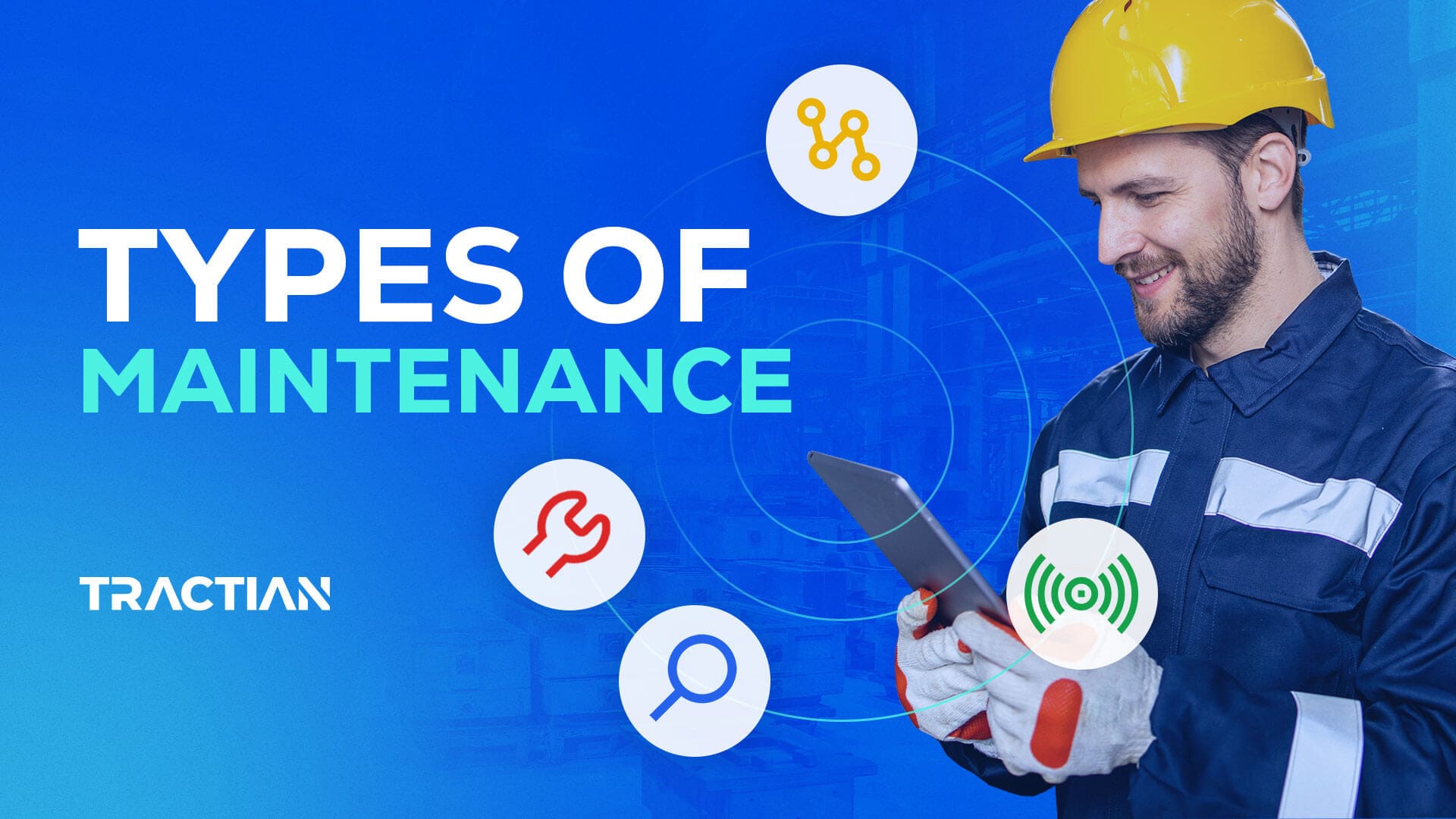You’ve most likely heard the term “industrial maintenance activities”, but what does that mean? In general, it refers to the processes required to take care of machines in the industry. There are four main types: corrective maintenance, preventive maintenance, predictive maintenance, and proactive maintenance. Without knowing about these in detail, challenges can arise.
For a maintenance plan to be as assertive as possible, the manager must master all maintenance types and subtypes. This helps them designate the correct method for each piece of equipment. Once that decision is made, they will define what, where, and when the maintenance plan should be executed.
In this piece you’ll get to know the most important types of maintenance, their differences, and their ideal application situations. This content has been adapted by TRACTIAN based on the widely-known “Maintenance Engineering Handbook, Eighth Edition”, by R. Keith Mobley.
And don’t forget: the ideal maintenance plan takes all types and subtypes into consideration. Doing this by emphasizing the application of smart, technological tools can make maintenance activities even more accurate and profitable.

Corrective Maintenance
The oldest type of maintenance, which is also the most expensive, is known as corrective maintenance. All of that aside, corrective maintenance isn’t bad and shouldn’t be left out of plans and maintenance tasks.
Corrective maintenance consists of fixing or replacing components after failure, or when it’s about to happen. It’s often unscheduled – delaying production and costing money – increasing its financial impact.
Emergency corrective maintenance should be avoided with the help of the other types of maintenance, but can be included in the plan when scheduled. But, not everything is predictable or avoidable. Managers should always be prepared for the repair of critical equipment or a “surprise” replacement.
Unplanned Corrective Maintenance (CNP) / Unplanned Maintenance
This is what we call “emergency” or “reactive” maintenance. It consists of unplanned maintenance activities done after the failure has happened.
Unplanned corrective maintenance is just that – unplanned. The idea is that the machine failure preceding a corrective activity occurs in less critical equipment. This way the financial impact is lower, allowing you to be cost effective and continue production.
To make sure the most important assets don’t need emergency corrections, managers should prioritize other maintenance techniques in the plan. This can mean using tools such as condition monitoring of critical assets.
Planned Corrective Maintenance (CPL)
Also known as “urgent”, planned corrective maintenance happens after a functional failure in a machine has occurred. It’s used to solve problems that aren’t directly affecting the full operation of the equipment.
This kind of corrective maintenance is programmed, making it less expensive, safer, and faster than emergency corrective maintenance. Once planning is done, it can be applied to assets of both low and high importance.
Preventive Maintenance
Preventive maintenance is essential to ensure the efficiency and reliability of industrial machinery. It’s associated with the detection, replacement, and repair of components and assets before any failures can occur.
Preventive activities work to decrease the chance of equipment failure, which usually arises from the improper operation of machines. These techniques are already known as periodic reviews, routine lubrication, calibrations, and inspections.
These inspections and procedures can be automated with the use of a CMMS software. To learn more about making maintenance activities automatic and more efficient, we’ve prepared this other article. Check it out!
Preventive techniques fall into two types: condition and time-based preventive.
Time Based Maintenance (TBM)
TBM is the one we usually call “preventive” in the sector’s daily maintenance schedule. Time-based maintenance is measured by the usage time of the physical asset in question.
TBM interventions are always periodic and fixed in the maintenance plan, and generally do not require specialized labor. This means they can be executed by the maintenance team’s own operators, usually after company training. Time-based maintenance includes visual inspection, lubrication, machine cleaning, and predicted part replacement – depending on the asset’s lifespan.
TBM is great for saving resources, extending equipment lifetime, improving operation, and preventing accidents. It’s common to set shorter intervals for preventive activities, which leads to unnecessary stoppages and replacements. Instead, combine this technique with another more assertive and data-based one.
Condition-Based Preventive Maintenance (MPC or CBM) / Condition Monitoring
You may have heard someone call “predictive” what is actually condition-based preventive maintenance. This maintenance activity is performed after the periodic diagnosis (time-based maintenance plan).
Unlike preventive maintenance, condition monitoring is based on the actual condition of the physical asset. It uses tools like vibration analysis, thermography, oil analysis, and acoustic emission to monitor asset condition.
The main tool used here, and which justifies its nickname, is another type of maintenance – predictive maintenance. Real-time data collection and detailed diagnostics from predictive tools make it possible to define, plan, and put in place precise preventive actions.
Unlike time-based maintenance, condition monitoring requires advanced technical knowledge and is usually outsourced to specialist companies. However, technologies have emerged in recent years that are able to fill this need for hyper-skilled manpower. They are easy to implement and control, requiring no specific training.
Predictive Maintenance
Like the condition-based preventive maintenance, predictive maintenance is based on the current conditions of the asset. Predictive maintenance work can be classified as routine monitoring, ideally performed in real time. It can be done offline as well as online.
Predictive monitoring aims to reduce possible failures and equipment wear. This is done through data collection, data analysis, and the measurement of variables and performance parameters. Once collected, that data is analyzed and you can see the condition of your assets.
Some of the smartest and most useful tools for maintenance today come from predictive maintenance practices, like condition monitoring software.
With these tools, the manager is aware of everything that happens inside and outside the equipment – 24 hours a day, 7 days a week. They can receive diagnoses and accurate data to help in the preparation of a strategic plan. Corrective and preventive activities can then be scheduled in a purposeful and wise way, not unnecessary and random.
Proactive Maintenance
When you have both predictive and preventive maintenance approaches, they work together to create a proactive maintenance strategy. By collecting and analyzing machine data, you’re able to create this strategy. The goal is to identify and fix machine faults before they become failures.
Because wear and tear is inevitable, proactive maintenance focuses on machine reliability and reduced downtime. This helps managers delegate resources if, and when, necessary. Having a proactive maintenance plan not only creates efficiency, it can extend the life and increase the reliability of your machines.
Proactive Maintenance is not tied to a schedule. It’s aimed at common failures, suggesting interventions based on calculated possibilities from the analyzed data.

Sensitive Predictive Maintenance – Inspection Routes (MPS) / Sensitive Maintenance
This type of maintenance works to identify the condition of physical assets through sensitive routes. This means that it uses the four senses of the maintainers – sight, hearing, smell, and touch – to evaluate the assets. It looks for potential flaws – kind of like an investigation.
At first glance it may seem simple, but it’s a job that requires a lot of attention from employees. Attention to the smallest details is key. They will then use that information to compare it to the ideal conditions for each asset.
This investigative character brings us back to detective maintenance, which is a variation of sensitive predictive maintenance. It consists of a set of processes, and their purpose is to verify the protection systems attached to machinery and equipment.
Monitoring Predictive Maintenance (MPM)
Predictive maintenance and monitoring predictive maintenance are extremely similar, because the goal of using MPM is to identify the operating condition of physical assets. It does this through constant measurements of quantitative parameters such as temperature and vibration.
It’s a diagnostic activity that looks for potential failures. These are problems that have not yet happened, but have already begun to leave symptoms in the equipment. The investigative medium of MPM is not the four senses of the maintainers. Instead, it is done through 24/7 data collection.
In order to have around the clock data collection, you’ll need condition monitoring software. It’s based on artificial intelligence, Internet of Things (IoT), machine learning, and data science – these tools allow failure symptoms to be detected and interpreted. This way everyone knows exactly what, when, and where fixes must be done to avoid problems.

Which Maintenance Strategy Is Right For You?
No single type of maintenance works for every asset. The most effective teams design a hybrid strategy using preventive maintenance for routine upkeep, condition-based or predictive approaches for critical assets, and operational maintenance to keep equipment in baseline condition every day. A mature strategy also integrates proactive maintenance to eliminate root causes and reduce future workload.

Tractian makes this hybrid approach easier to execute. Our platform combines AI-driven condition monitoring with a mobile-first CMMS, so you can plan, track, and optimize every type of maintenance from one place:
- Condition-Based & Predictive: 24/7 vibration and temperature monitoring with AI diagnostics to detect failures before they cause downtime.
- Preventive & Operational: Automated scheduling, digital checklists, and mobile access to keep routine tasks on track.
- Proactive & Corrective: Fault history analysis and root cause tracking to stop recurring issues at their source.
At the core of our condition monitoring capabilities is Smart Trac, TRACTIAN’s patented IoT vibration and temperature sensor. Smart Trac continuously learns the behavior of each machine, identifying even the smallest signs of wear or imbalance. The data is instantly analyzed and made available to the entire team through our intuitive platform. Everyone from frontline technicians to plant managers has the same real-time view of asset health, enabling faster, more informed decision-making.
When a potential issue is detected, managers can automatically generate work orders, assign them to the right technician, and schedule repairs for the most efficient time. This reduces guesswork, improves planning accuracy, and ensures resources are deployed exactly where they are needed. The process also frees up staff to focus on higher-value activities instead of firefighting unexpected failures.
By combining multiple maintenance types with accurate, real-time insights, Tractian helps your operation become leaner, more reliable, and more profitable. You can reduce unplanned downtime, extend asset life, cut unnecessary costs, and empower your team with the tools to perform at their best.
If you’re ready to unify your maintenance strategy and transform your results, schedule a demo with one of our experts today.


